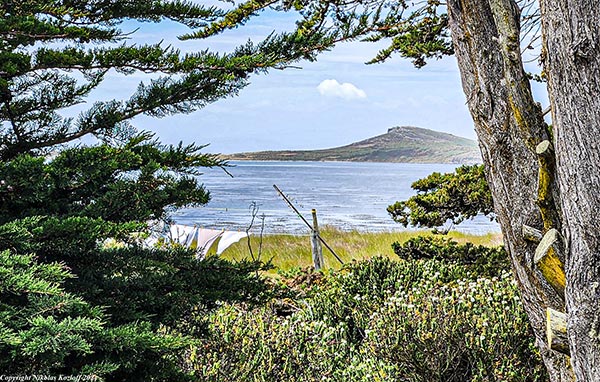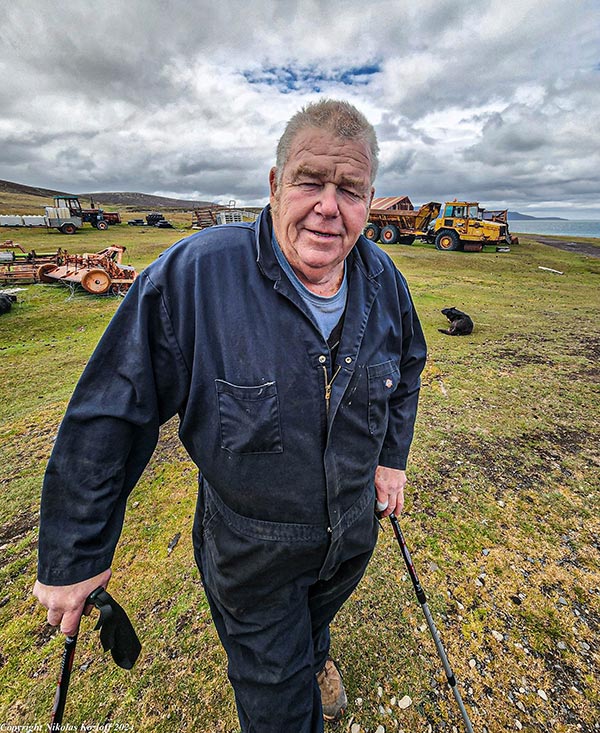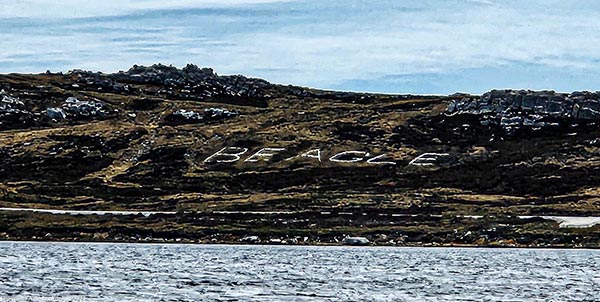
Darwin and the Environmental Promise of South Atlantic Kelp Forests
At the risk of asking a somewhat grandiose question, will we be able to adapt to climate change, or alternatively face extinction? If he were alive today, it’s a question which might have vexed Charles Darwin — though the naturalist would not have denied environmental change, the colossal pace of global warming would have undoubtedly startled him. Even though Darwin’s travels in the Falkland Islands are somewhat overlooked, his observations pertaining to the ocean environment are vitally important when dealing with such questions. More specifically, the scientist took in the archipelago’s plentiful kelp forests — underwater canopies comprising veritable jungles of brown seaweed —which may prove essential in addressing earth’s climate crisis.
From 1832-1835, Darwin sailed across South America aboard HMS Beagle, during which time he made key observations pertaining to wildlife which would later inform the theory of evolution. However, while he was in the Falklands, the scientist also came close to embracing such modern concepts as food-chain, food web and ecological niche. Darwin noted how the sea hosted a complex web of marine life, with kelp beds providing a crucial link between humans and the environment. “On shaking the great entangled roots,” Darwin wrote, “it is curious to see the heap of fish, shells, crabs, sea-eggs, cuttle fish, star fish,” and worms which fall out. “One single plant form is an immense & most interesting menagerie. If this fucus was to cease living, with it would go many: the seals, the cormorants & certainly the small fish & then sooner or later the Fuegian man must follow.”
Recently, I retraced Darwin’s travels in South America in tandem with a book project dealing with the naturalist’s legacy in the context of climate change. Sailing with Darwin200 Initiative, a scientific expedition in the South Atlantic, I was keenly interested in revisiting Darwin’s kelp forests, which provide many benefits for both nature and people. Indeed, the ecosystems host thousands of species, help cycle nutrients, and mitigate ocean acidification as well as storm damage. Recent findings suggest kelp can assist in carbon removal and therefore act as veritable “carbon sinks.” Unfortunately, underwater forests are disappearing at a concerning rate in many parts of the globe due to threats such as climate change.
Inhabiting shallow waters off one third the world’s coastlines, kelp forests could represent substantial financial holdings, since they provide “ecosystem services,” that is to say benefits ranging from storm protection to climate regulation to providing recreation and commercial food supply. To be sure, scientists and environmentalists seek to protect existing kelp, though others have turned to aquaculture. Rapid expansion of industrial-size aquaculture projects such as fish farms have given rise to environmental problems in the past, but the kelp boom already has entrepreneurs farming several types of seaweed as a crop. Others are exploring simple seaweed restoration aquaculture for non-commercial purposes.
The Falklands are home to some of the most pristine kelp forests on earth, and within local waters, giant kelp or Macrocystis pyrifera is typically the largest and most abundant component of underwater forest assemblage. The ecosystems support invertebrates and fish, while providing important breeding grounds for squid, not to mention feeding grounds and shelter for mammals and marine birds. For the time being, Falklands kelp systems appear to be healthy, and there is no evidence that warming has resulted in kelp loss. However, experts are concerned about the potential effects of climate change, not to mention other factors such as tourism and invasive species linked to biosecurity. Though kelp is somewhat resistant to severe temperature shifts, increased storms and other changes could prove damaging to ocean habitat.
Seasick and unaccustomed to sailing, I began to understand what life must have been like for Darwin. Indeed, while traveling in the Falklands, the naturalist was in a foul mood and called the place desolate and “miserable.” After a week or so sailing on tall Dutch ship Oosterschelde, we finally arrived on remote Saunders Island, lying northwest of West Falkland. Without a soul in sight, my shipmates and I hiked to a sparsely populated settlement where I met David Pole-Evans, owner of Saunders Island. Sheep grazing has given rise to its own share of environmental problems, and so I wanted to know: could kelp farming provide a sustainable economic alternative for the islands? Perhaps kelp farming could be developed, he remarked, though “no one’s doing anything about it.”

A few days later, I felt relieved as we made landfall in Port Stanley, located on East Falkland. Darwin’s legacy looms large here, from the word Beagle etched into the side of a hill to a distillery offering gin mixed with “Darwin’s botanicals.” On a blustery day, I met up with Amanda Curry Brown, Director of Policy, Economy and Corporate Services for the Falklands Islands government. The authorities had explored kelp farming in the past, she remarked, but without a lot of progress. For sheer economic return, she added, kelp could not match the potential benefits of oil exploration on the high seas. Mike Jervois, the islands Biodiversity Protection Advisor, told me the authorities are evaluating plans for offshore oil, though such development should be accompanied by an environmental assessment.
How could there be a debate over such questions in 2024, when the environmental advantages of kelp are so clear, whereas oil development would exacerbate climate change? The current plight of global kelp forests would have concerned Darwin, who marveled at the “striking…numbers of kinds of organic beings which are intimately connected with the Kelp.” The naturalist even contrasted kelp forests with tropical forests, remarking “I can only compare these great forests to terrestrial ones in the most teeming part of the Tropics; yet if the latter in any country were to be destroyed I do not believe that nearly the same number of animals would perish in them as would happen in the case of Kelp. All the fishing quadrupeds & birds (& man) haunt the beds, attracted by the infinite number of small fish which live amongst the leaves.”
Paul Brickle, a marine ecologist and CEO of SAERI (South Atlantic Environmental Research Institute), told me Darwin’s impact on scientific studies in the Falklands is “massive.” The expert was in awe of the Beagle’s original nautical charts from the Falklands, which illustrated the extent of kelp forests during Darwin’s voyage. Remarkably, the original maps are quite accurate and line up to a large degree with current satellite imagery pertaining to kelp. That’s good news, the expert said, since it indicates the kelp “is in a pretty safe sweet spot at the moment.”
Brickle and his colleagues have conducted a survey tabulating the total surface area and density of Macrosystis giant kelp, which provides nurseries for commercial fish species. In all, kelp offers a whopping £2.63 billion a year in ecosystem services for the Falklands Islands environment and local inhabitants. Though there had been talk of commercializing kelp, Brickle said, the problem lay in sheer distance from markets and cost of shipping.
Brickle’s team also calculated the “blue carbon” sequestration potential of Falklands kelp. To be sure, the ecologist told me, “there is always a big question about sequestration with kelp because it floats. Some of that carbon will be released back to the atmosphere, and some will be buried. And that is the big question mark, the enigma.” Nevertheless, Brickle and his colleagues’ study “illustrates the importance of maintaining kelp ecosystems in a healthy state…including their overlooked role as significant long-term carbon sinks.” Recent analysis, moreover, demonstrates potential for macroalgae sequestration in deeper waters, a habitat which is thought to “have a much more substantial role as a carbon sink…than previously thought.”
Listening to Brickle, I’m beginning to feel bullish about kelp and its environmental potential. Entrepreneurs are interested in launching a massive seaweed farm in the South Atlantic which could suck up a billion tons of carbon dioxide every year from the atmosphere, later sinking it down to the ocean floor. The engineering challenges would be huge, Brickle remarked, though in theory such schemes could hold ecological advantages. One would have to work out the environmental impact of dropping large bundles of kelp onto the seabed, he says.
In the meantime, Brickle is simply interested in monitoring existing kelp forests and future threats. He’s concerned, for example, about invasive kelp such as wakame. Ocean warming, meanwhile, may reduce the urchin population, which would in turn lead to a proliferation of other algal species. So, the kelp would simply disappear in such a scenario, I ask? “Likely, yes.” In addition, if there’s problems with kelp, then calamari squid would not have anywhere to spawn. “That sounds like a crisis,” I remark. “It is a bit, yes.”


Leave a comment